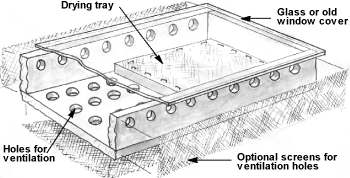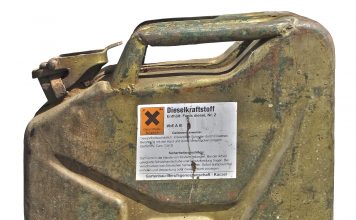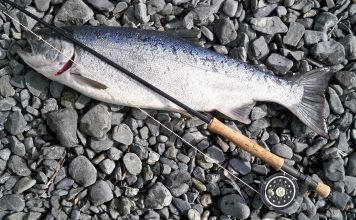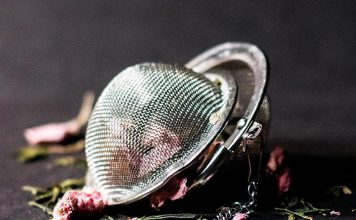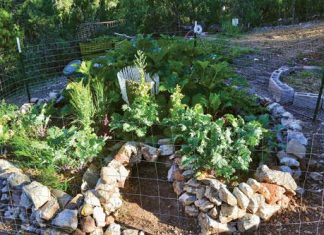| Issue #58 • July/August, 1999 |
The oldest known method of food preservation is drying food using the heat from the sun. Unfortunately it has become the least used as freezers and pressure canners have taken its place. While these methods of food preservation are certainly effective, they have drawbacks when compared to solar food drying.
Freezing is quick and easy but requires purchasing an expensive freezer if you don’t already own one. It also requires electricity (or other form of energy) to operate. Unless you are “off-the-grid,” a power outage can result in food loss.

Canning food requires more work than freezing but is generally unaffected by power outages. The initial expense of getting started can be substantial if you have to purchase the canner itself and related items like jars, lids, etc., and new lids must be purchased each year. Also, a source of energy is required, (electric, wood, gas, propane, etc.) while preserving, and canned food requires a lot of storage space.
Preserving food by solar drying requires no energy except the heat of the sun. Dried food also requires no energy to maintain it while stored. Related expenses are practically nothing, and little storage space is required. Drying food is easy to do and doesn’t require any special skills or equipment.
Dried food is excellent for hiking and camping because of its light weight and compact size. Several days rations can easily be placed in a backpack or your pockets. Best of all, dried food is delicious and nutritious.
Solar drying basics
Dried food is preserved by its moisture content, or rather the lack of it. It is always better to have food overly dry than not dry enough. Mold, due to inadequate drying, is the main cause of food spoilage while stored.
Climate can affect solar drying. The ideal climate is one with low humidity and bright, strong sunshine. If you live in a humid or rainy area you may wish to dry foods with a dehydrator or in the oven. While drying in this manner will require some form of energy, the other benefits of dried food will still be available to you.
Do not dry your food outside in an area with a lot of traffic or air pollution. Contamination is possible from airborne emissions.
After food is prepared for drying, spread it in a single layer (pieces not touching) on drying trays and place in a sunny spot which permits good air circulation. Turn food daily. Dry strong-flavored or odored foods by themselves.
Drying trays can be made by simply using a frame and covering it with cheesecloth or plastic screen. Stretch tightly and fasten on the back with staples or tacks. A string can be placed across the back for reinforcement to prevent sagging (See illustration).
Do not use metal screen unless you cover it with cheese cloth. It may contaminate or ruin your food. Window frames, window screens, door frames, or discarded screen doors all make good drying trays. Set the tray on rocks or pieces of wood to permit air circulation from all sides. If insects are a problem while drying, loosely drape cheesecloth or other such fabric over the drying food. Arrange it so it does not touch food or it may stick.
To intensify the heat from the sun, an old window or piece of glass, can be placed above the food on the drying rack, allowing several inches of space for air circulation.
A simple solar dryer can be built from scrap material and an old window. Build a box similar to a gardening cold frame and cover with a piece of glass or plastic. Ventilation holes can be covered with screen to control insects if you wish. If the temperature inside gets too high (over 135-140 degrees F) provide more ventilation by raising the glass top a few inches.

Selecting a warm spot, like a heat reflecting driveway or roof-top, can help also.
Bring your trays inside at night or if rain threatens. Finish drying in the oven or over your heating stove if necessary.
Variables like your particular locality and climate, humidity, heat, and the food itself can affect the length of time it takes for food to dry, so it is impossible to give specifics. The following guidelines offer some dryness indications for particular foods.
Harvest your fruits and vegetables when they are at the peak of flavor. It is better if they are slightly immature than overly ripe.
Never place dried food which is still warm directly into the storage containers. Always let it cool completely first.
Fruits
Wash and dry fruit. Peel if desired and slice thinly. Apples, peaches, and other fruits may darken when exposed to air. This is caused by oxidation which can damage flavor and vitamin content. To prevent oxidation you can dip the fruit slices in a preserving solution. One solution is a salt water dip which is made by adding six tablespoons of pickling salt to one gallon of water. Soak for two to three minutes, then drain. Pat dry. Another solution is two tablespoons of ascorbic acid powder to one quart of lukewarm water. Soak, drain, and dry as above. Commercial fruit preservatives can also be purchased for this purpose.
Fruits are dry when somewhere between leathery and brittle. Drying times are affected by a number of factors, so experience and common sense are the best guides. After sun drying fruit it needs to be “equalized.” Remove from trays and place in a bowl inside the house. Several times per day, for one week, stir the fruit pieces. This will allow any moisture from pieces that are not totally dry to be transferred to those which are overly dry.
Another way to equalize dried fruit is to place it in a paper bag after removing from drying trays. Fold over the top of the bag and hang from the clothesline. Shake gently several times a day for two days.
Fruit leathers
Overripe fruit can be used to make fruit leathers and is actually better than fruit which is at its peak. To prepare fruit for leathers, rinse then turn into puree by grinding, putting through a food mill, or mashing with a potato masher. Remove peels, pits, and seeds. Add fruit juice if necessary until it is of a consistency that will pour. If the fruit is too runny, thicken by cooking over low heat to evaporate water or add a thickener, such as wheat or oat bran.
Sweetening or spices can be added if you choose. Begin by adding only one to two spoons of sweetener since many totally ripe fruits need nothing more. If you are making leathers from light colored fruits such as apples or peaches, heat to almost boiling before beginning to dry. This will help prevent browning.
Fruits can also be combined. Some good combinations are cherries and rhubarb and strawberries and rhubarb. All of the small berries like raspberries, blackberries, and mulberries go well together.

Line a cookie sheet or tray with plastic (don’t use wax paper or foil) or coat with a non-stick vegetable spray or cooking oil. Pour the puree in and spread evenly by tilting the tray or sheet back and forth to spread it out. The thinner and more consistent the thickness, the better and quicker it will dry. One-eighth of an inch thick works well. If it is too thick it may spoil before drying, and if not consistent it will not dry evenly.
When top side is dry, remove from backing and turn over. Let the other side dry. Cut into squares or strips and roll up. Leather which is slightly sticky to touch will keep for about four to six weeks. Leather which is completely dried will keep longer but may be too brittle to roll.
Store leather in airtight containers with plastic wrap or paper between them to prevent sticking. Leather can be used as snacks or dissolved in water and used in any recipe calling for fruit.
Vegetables
Vegetables, like fruits, should be harvested at their peak of flavor. Wash to remove dirt, then prepare for drying by peeling, slicing, etc., as desired.
Controversy abounds over blanching vegetables before drying. Some insist on it, while others feel it is not necessary and successfully preserve without it. To blanch vegetables, steam them over boiling water until they are heated throughout and look translucent when cut with a knife. Remove from steamer and cool immediately with cold running water or plunging into a pan of ice water. Drain, then pat dry with cloth or towel.
Spread on drying trays, as with fruits, and dry in the sun. Most vegetables are dry when they are brittle and will shatter when struck. Slices will snap when bent.
Storing dried food
Often fruit, even when dry, will stick together when stored. A tasty way to help prevent this is by “dusting” before storing. Powdered sugar, spices, or powdered oats can be used as “dust.” Place it in a bag then add fruit and shake to coat the pieces. Dusting fruit leather or placing pieces of paper between the rolls will prevent them from sticking.
Almost anything can be used as a storage container, as long as it has a tight fitting lid. Recycled jars or other containers work well, as well as storage bags or canning jars. If using a metal lid, place a piece of paper between the food and lid. Light causes oxidation, so store the dried food in a dark place or put the containers inside paper bags or a cardboard box to block light. Keep in a cool place.
Storing in small batches is wise. In the event one piece is not dry, it will not ruin the entire batch. Check weekly for signs of mold for the first several weeks. Label the food before storing.
Using dried foods
Add dried vegetables to soups or stews. The liquid will “re-hydrate” them while cooking. They can also be used in casseroles, sauces like spaghetti, and in nearly any recipe requiring vegetables.
Fruits can be eaten as they are for snacks. They can also be “re-hydrated” by soaking or cooking in juice. The warmer the liquid, the quicker the fruit will soak it up. Use dried fruits to stew, in baking, jams, sauces, or for syrups.
Dried foods will keep a minimum of six months in storage under the proper conditions.
Drying meat
Most USDA publications and home economists discourage drying as a means of preserving meat. While canning and freezing is the safest means of preserving meat, drying has been done successfully for centuries.
This is another controversy that you will have to decide for yourself.
Jerky is the most common type of dried meat. Nearly any type of meat can be made into jerky as long as it is parasite-free. Meat which has been frozen, then thaws (as in a power outage), can be made into jerky.
Begin by trimming off any fat or connective tissue. Remove the bone. Cut into strips one-half inch thick or less. You can parboil at this time if you wish, but it is not necessary.
The next step is to soak the meat in a seasoned brine. There are many different recipes for this brine or marinade. The easiest brine is one pound of pickling salt in one gallon water. Some folks prefer a more seasoned brine of spices, Worcestershire sauce, sugar, etc. Experiment to find your favorite. Soak the meat in the brine for 24 hours, then rinse and dry. You can also rub the seasoning in by hand, then wait a few hours and dry. Keep meat cool while it is absorbing the seasoning.
Meat is dried like fruit and vegetables. Hang the strips on racks or drape over sticks in an area with good air flow that receives full sunlight. A fire can be built nearby to give the meat a smoked taste and speed drying time if you wish.
Protect from insects with cheese cloth or other such fabric. A recycled “accordian” type clothes dryer works wonderfully for a drying rack. Since it is mobile, it can be moved close to the fire or brought inside at night so the meat can finish drying. It can also be cleaned with hot soapy water after use.
Meat is ready for storage when it is completely dry. It should be somewhat flexible but brittle enough to break when it is bent in half. Store like dried fruit or vegetables.
Jerky can be eaten as is or re-hydrated by simmering in broth or water. It can be added to soups, stews, etc.
Bananas, rhubarbPeel, slice in thin roundsBrittle
| Guidelines for Fruits and Vegetables | ||
| Food | Preparation | Dryness test |
| Apples, pears, peaches . | Wash, core, and peel. Cut into 1/4″ slices or rings | Leathery with no moisture when cut |
| Apricots, plums | Wash, halve and pit. “Pop” backs. |
Leathery and pliable No moisture when cut |
| Berries | Sort, wash, and remove stems. | Brittle and hard |
| Cherries, grapes | Sort and wash. Pit cherries. | Slightly sticky, like raisins |
| Asparagus tips | Wash, blanch 3 minutes. | Leathery to brittle |
| Beans, cabbage, peppers | Wash, chop into small pieces. Blanch 4 minutes | Brittle |
| Broccoli, cauliflower | Wash, trim, and chop. Blanch 3 minutes. | Brittle |
| Carrots | Wash, cut into slices. Blanch 3 minutes. | Dry and brittle |
| Corn | Husk, trim, cut off cob. | Dry and brittle |
| Mushrooms | Wash, sort, and slice 1/4″ thick. | Dry and brittle |
| Onions | Remove outer skin, then chop. | Brittle |
| Peas | Shell and sort. Blanch 3 min. | Brittle |
| Squash, zucchini | Wash, peel, remove seeds. Blanch 2 minutes. | Leathery and tough |
| Tomatoes | Scald, chill, and peel. Slice into quarters. | Leathery and tough |


